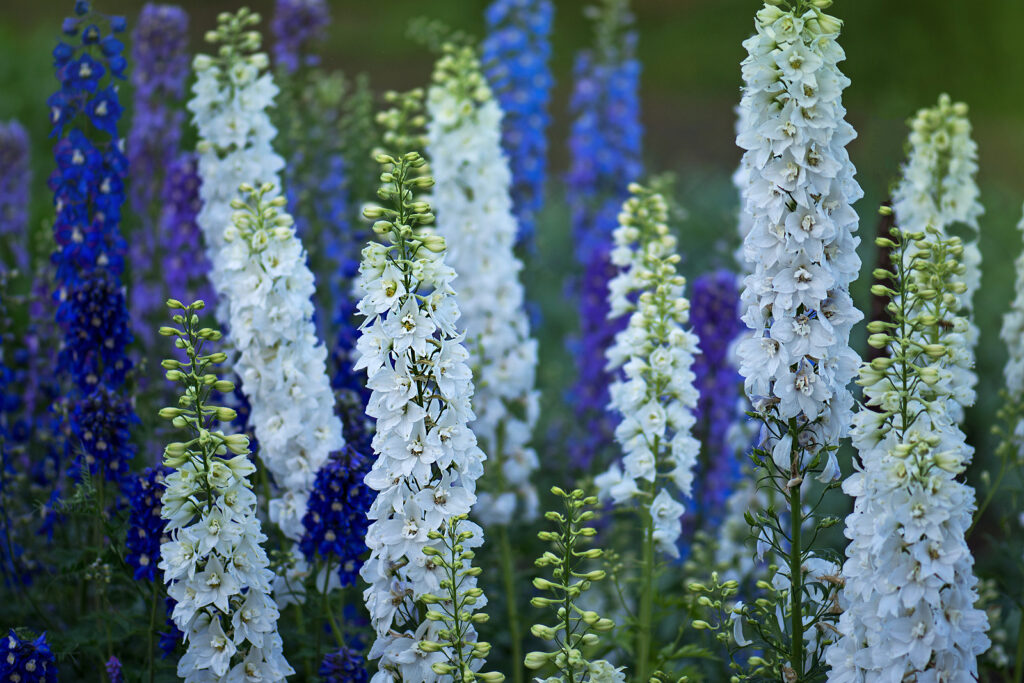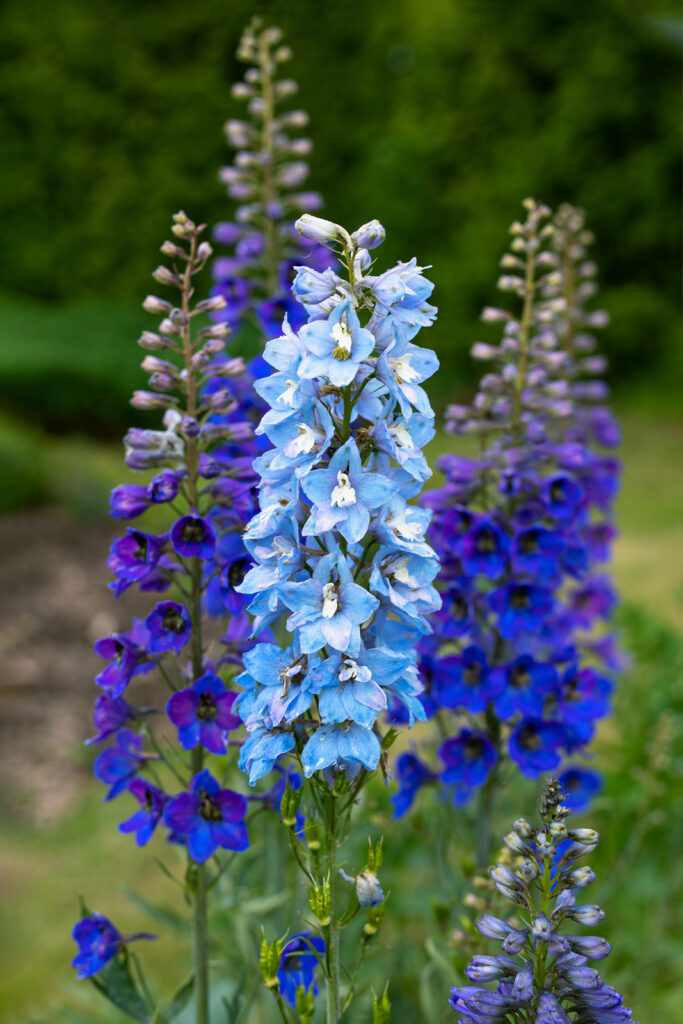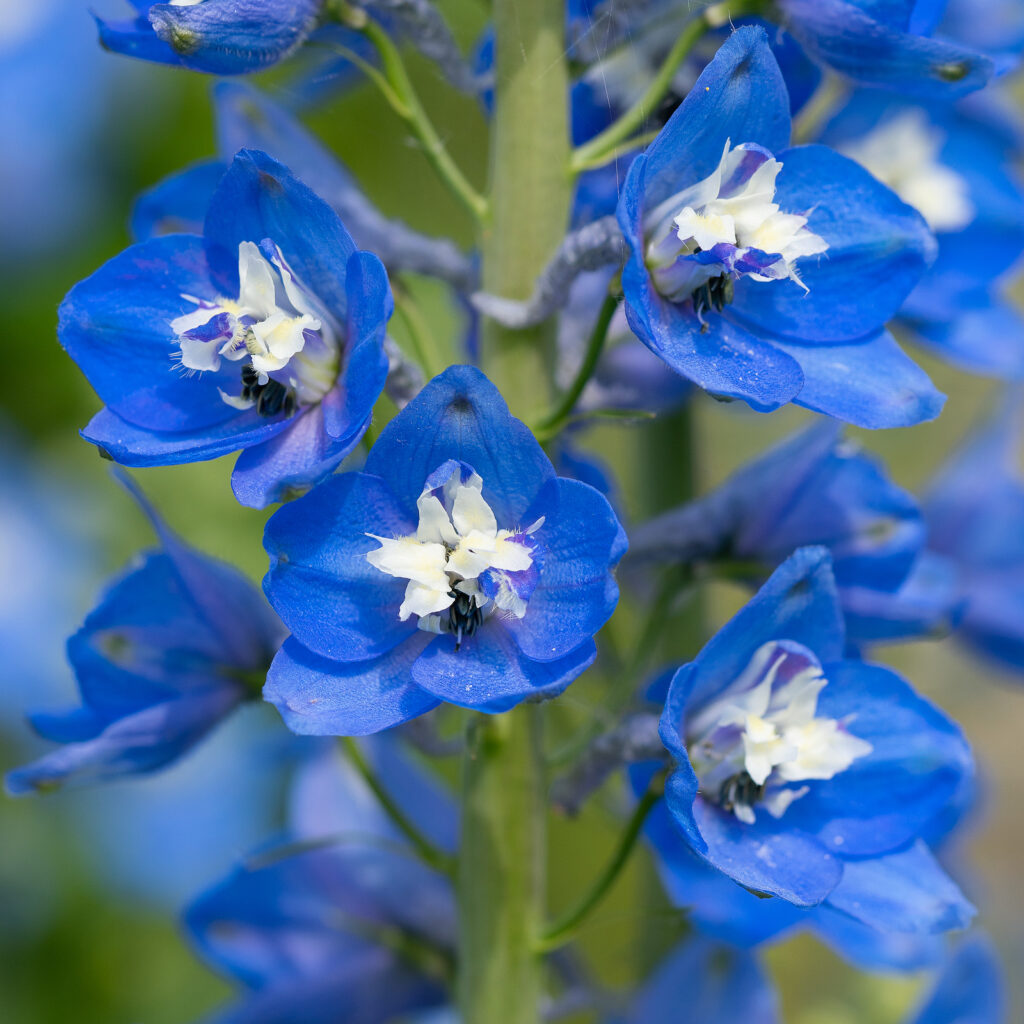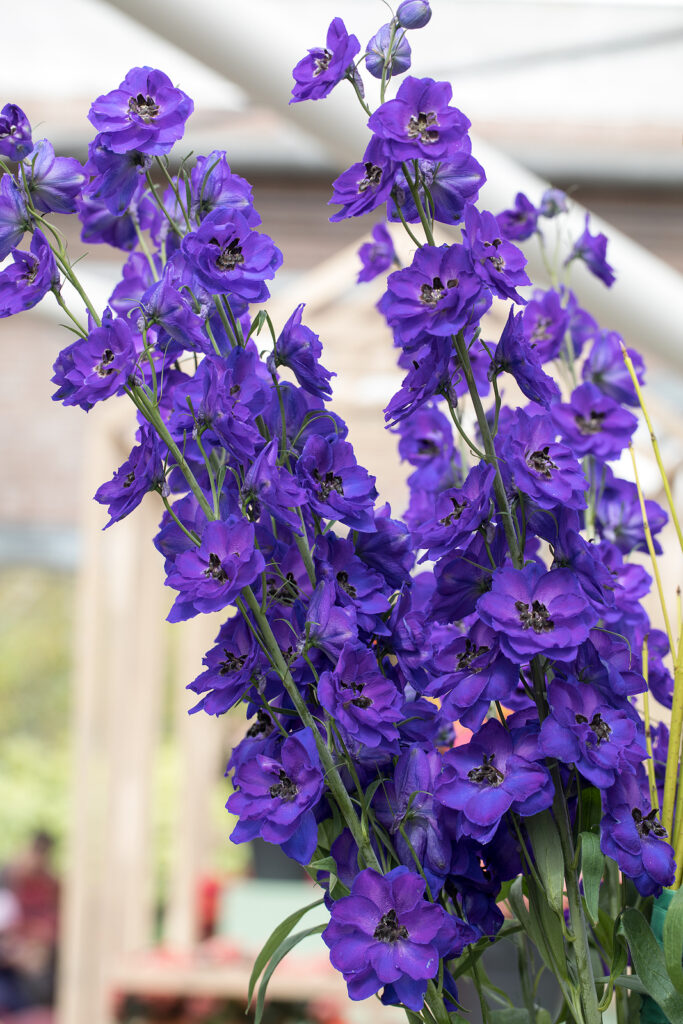Delphinium produces tall showy spikes of brightly colored flowers in summer. Blooms come in a range of colors—blue, violet, pink, white, or two-toned.
The delphinium’s tall wand of flowers emerges from a low mound of foliage. Columns of blooms grow from 3 to 6 feet (.9-1.8m) tall or more. Leaves are lobed or fanlike and variously cut or divided.
Delphiniums grow best where nights are cool and days are warm. Delphiniums appreciate shade during the middle of the day. Delphinium does not tolerate wind, heat, drought, or poorly drained soil.
Delphiniums are an excellent choice for borders and cut flowers. Low-growing types are well-suited for containers. Delphinium flowers attract all types of birds to the garden.
The annual delphinium is larkspur; see Consolida ambigua.
Flower Garden Success Products at Amazon:
- Wildflower Seed Mix Attracts Hummingbirds and Butterflies
- Eden Brothers All Perennial Seed Mix
- 10 pcs Stainless Steel Garden Hand Tool Set
- Gorilla Cart 4 Cu. Ft, 300-pound Capacity
- Neem Bliss 100-% Cold Pressed Neem Oil
- Safer Brand Insect Killing Soap

Get to know Delphinium
- Plant type: Perennial
- Growing zones and range: Grow as an annual in Zones 2 to 7; grow as a perennial in Zones 6 to 7 where summers are cool.
- Hardiness: Hardy to -35°F (-37°C); good choice in cool summer regions, not suited for hot regions
- Height and width: 3 to 7 feet (0.9-2.1m) tall; 1 to 3 wide (.3-.9m)
- Foliage: Basal leaves are toothed and deeply or shallowly lobed to 8 inches (20cm) long
- Flowers: Flower spikes are 12 to 15 inches (30-38cm) long; single flowers are 2 inches (5cm) wide.
- Flower color: Intensely blue flower spikes, also light blue, lavender, pink, purple, red, and white
- Bloom time: Early summer
- Uses: Good addition to mixed borders
- Garden companions: Shasta daisy, veronica, sunflower, Joe-Pye weed, anise, hyssop, fragrant bugbane, ornamental grasses.
- Common name: Delphinium
- Botanical name: Delphinium elatum
- Family: Ranunculaceae
- Origin: Mountainous areas worldwide

Where to plant Delphinium
- Grow delphiniums in full sun to partial shade.
- Plant delphiniums in humus-rich, moist, well-drained soil.
- Delphiniums grow best where the soil pH is 6.5 to 7.5.
- Delphiniums thrive in regions with cool summers; in hot summer regions; plant delphiniums where there is morning sun and partial shade in the afternoon.
- Plant delphiniums where there is good air circulation to help prevent disease.
Delphinium uses and companions
- Grow Delphinium at the back of formal gardens.
- Delphiniums are traditional cottage garden plants along fences.
- Del[hiniums combine well with iris, peonies, daylilies, Shasta daisies, and lilies.
- Good garden companions for Delphinium include Chrysanthemum superbum, Heliopsis helianthoides, Hemerocallis, Monarda, Iris (Siberian).
When to plant Delphinium
- Set established plants in the garden in spring or autumn.
- Start seeds indoors in early spring or late summer (for bloom the following year). Sow seeds on the surface of pre-moistened soil. At 60°F (15.6°F) germination will occur in 2 to 4 weeks. Harden seedlings off for 2 weeks before setting them in the garden.
- Sow seeds in prepared beds in early spring or late summer.
- Container-grown plants can be set in the garden in spring or fall.
Planting and spacing Delphinium
- Space delphiniums 1 to 3 feet (30-91cm) apart.
- Dig in compost and well-rotted manure at planting time; grade the soil so that it will not collect water.
- Set transplants in the garden so that roots are securely covered with soil.

How to water and feed Delphinium
- Keep the soil evenly moist when growing delphiniums. Do not let the soil dry out. Avoid wetting the leaves when watering.
- Constantly wet soil leads to crown rot and death.
- Fertilize delphiniums every 6 to 8 weeks with an all-purpose fertilizer.
Delphinium care
- Mulch around delphiniums to conserve soil moisture.
- Delphinium is prone to disease where summers are warm.
- Stake delphiniums when they reach 18 inches (45cm) tall. Use stakes as tall as the plants are expected to grow; tie flowering spikes to stakes. Cut off flowers just below the lowest flower; new growth will begin from the plant’s base.
- Remove spent flowers to encourage new blooms.
- Protect plants in winter by spreading a 3-inch layer of clean sand over the plants in late fall, or cover crowns with evergreen branches.
Delphinium pests and diseases
- Delphiniums are susceptible to attack by mildew, slugs, and snails.
- Aphids can infest young leaves and flower buds. Earwigs can damage flowers.
- Powdery mildew and fungal diseases can affect the leaves; plant delphiniums where there is ample air circulation.
- Crown rot can be a problem where the soil stays wet.
Good Products for Seed Starting Success at Amazon:
- Jump Start Germination Station w/Heat Mat Tray, 72-Cell Pack, Dome
- Espoma Seed Starting Mix
- 200 Count- Jiffy 7 Peat Soil Seed Starting Plugs
- Seed Starter Kit with Humidity Dome (120 Cells Total Tray)
- AgrobriteT5 Fluorescent, 2-Foot, Grow Light System

Delphinium propagation
- Propagate delphiniums by sowing seeds or cuttings.
- Seeds germinate in 21 to 28 days at 70° to 75°F (21-24°C).
- Take cuttings from shoots at the base of the plant in early spring; each cutting should have a sliver of the crown attached,
- Divide established plants every 4 years in early spring. Use a sharp knife to cut tangled roots.
- Propagate delphiniums from plant divisions frequently; delphiniums begin to decline after their second year.
- Handle the plants with care; the roots are brittle and break easily.
Delphinium varieties to grow
- Delphinium ajacis. See Consolida ambigua, larkspur, or rocket larkspur.
- Delphinium belladonna: bushy perennial with short-stemmed, airy flower clusters; easy to grow; shorter than D. elatum. D. belladonna has parented many hybrids, some grow to 4 feet tall (1.2m) tall; blooms have prominent spurs.
- Delphinium elatum: almost all delphiniums are hybrids of Delphinium elatum including Pacific hybrids which are considered the most spectacular; Pacific hybrids grow to 7 feet (2.1m) tall, included are ‘Blue Bird’ (mid blue), ‘Blue Jay’ (medium to dark blue), ‘Summer Skies’ Ilight blue). Other D. elatum hybrids include Blue Fountains and Magic Fountains; strains include lilac-pink, deep raspberry rose, lilac, lavender, royal purple, and dark violet. The Arthurian Round Table series includes ‘Astolat’ (lilac blue), ‘Black Knight (violet-black), ‘Galahad’ (white), ‘Percival (white and black), ‘King Arthur’ (violet).
- D. grandiflorum, Chinese or bouquet delphinium: bushy to 12 inches (30cm) tall; upward-facing blue flowers.
Delphinium frequently asked questions
Q: What’s the best way to germinate delphinium seed?
A: Start with fresh seed every year–delphinium seeds are short-lived. Be sure to cover the seeds; they need darkness to germinate. You can start seeds indoors 6 to 8 weeks before the first frost, but be careful when it comes time to transplant them, they do not like their roots being disturbed.. Set plants in the garden 1 to 2 weeks after the last frost.
Q: When should I sow delphinium directly in the garden?
A: Sow delphinium in the garden as soon as the soil can be worked in spring about 4 or 5 weeks before the last frost. Delphiniums prefer cool weather. Grow delphinium in well-drained, moderately fertile, alkaline soil in full sun or light shade.















